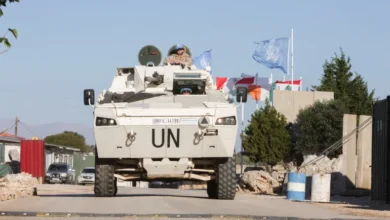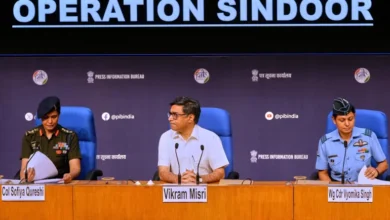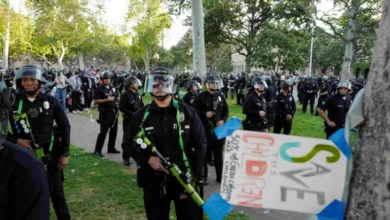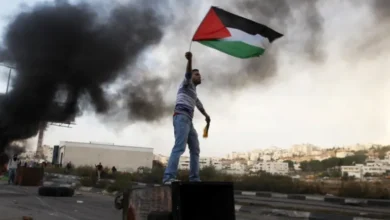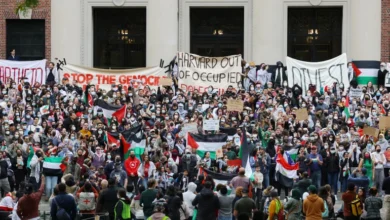Israel’s psychological operation in Gaza
Belén Fernández
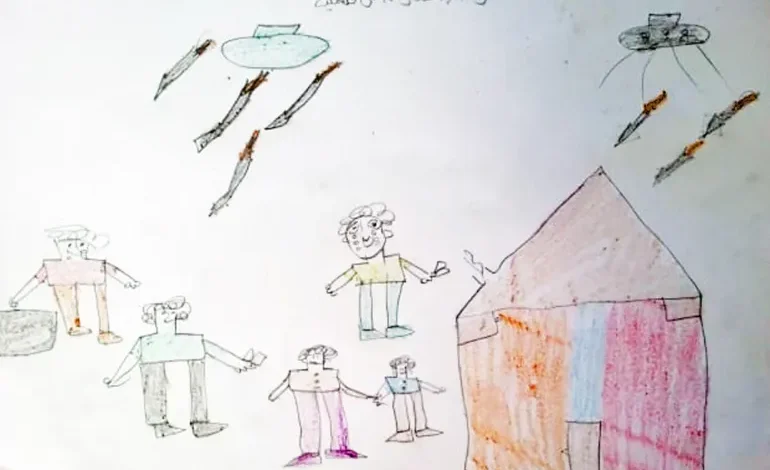
Belén Fernández
In 2014, nine years prior to Israel’s current annihilative efforts in the Gaza Strip, the Israeli army undertook what it dubbed “Operation Protective Edge” in the same territory. The 51-day campaign extinguished 2,251 Palestinian lives, among them 551 children.
Not long after the 2014 killing spree, a psychoanalyst acquaintance of mine in Barcelona sent me some photographs that he had acquired from a colleague in Gaza. The photos were of drawings by children in the town of Khuzaa in the southern Gaza governorate of Khan Yunis, close to the border with Israel.
At first glance, many of the drawings appear to be your standard children’s artwork, featuring colourful houses, smiling stick figures, grass, clouds, sun and so forth. Stylistic similarities aside, however, the illustrations depict a troublingly distinct landscape – one in which missiles, tanks, bulldozers and jets have clearly come to occupy central positions in the respective universes of the young artists.
In one drawing, for example, a projectile descending from the sky is about to impact an orange house with a red roof and a Palestinian flag flying overhead. In another, missiles from an aircraft are bound for a smiling stick-figure group. In offering a glimpse of the world as seen through Palestinian children’s eyes, the artwork also constitutes yet further proof of the psychologically depraved nature of Israel’s operations in the Gaza Strip.
The children who drew those drawings are now teenagers – provided, that is, that they have survived the latest ongoing round of Israeli-induced carnage in Gaza, which has killed close to 10,000 people including more than 4,800 children. There is not a single safe place in the entire territory, as Israel proceeds to target homes, schools and hospitals alike with abandon. Israeli military officers have admitted to dispensing with pretences to “surgical” precision.
Obviously, the conversion of daily existence in Gaza into a literal nightmare means that, even if the Israeli bombs stop falling, psychological trauma will remain the name of the game – presumably to a greater degree than it was already. Five years ago, the Norwegian Refugee Council (NRC) reported severe “mental health issues and psychological deterioration” among Gaza’s youth. In 2020, the majority of children in the besieged enclave were found to suffer from PTSD or post-traumatic stress disorder.
And in May 2021 – in a quintessential can’t-make-this-up episode of savage irony – twelve of the more than 60 children killed by Israeli air strikes on Gaza in one week were participating in an NRC psychosocial programme for victims of war trauma.
In addition to the physical slaughter, then, there appears to be a calculated effort to inflict psychological devastation in Gaza as well.
The English term “psyops” is not quite sufficient to describe what Israel is doing. According to the Merriam-Webster dictionary, psyops is a plural noun denoting “military operations usually aimed at influencing the enemy’s state of mind through noncombative means (such as distribution of leaflets).”
To be sure, Israel has long excelled at the practice of dropping leaflets from aircraft onto civilian populations in Palestine as well as in Lebanon, often with instructions to evacuate a given area; nowadays, such psyops are also easily conducted by cellular phone.
However, given Israel’s habit of bombing people as they comply with evacuation orders, none of this really qualifies as “noncombative means”. In the case of the blockaded Gaza Strip, from which there are currently exactly zero evacuation routes, this sort of psychological warfare becomes even more mentally disturbing.
Of course, there is nothing terribly psychologically reassuring about living trapped in an overcrowded sliver of land, even at times when Israel is not conducting an all-out war. Back in 2005, the year of Israel’s withdrawal-that-wasn’t from Gaza, the late Dr Eyad El-Sarraj – founder of the Gaza Community Mental Health Programme – condemned Israel for endeavouring to induce “learned helplessness to the Palestinians in Gaza with the aim of making the whole population captive to fear and paralysis”.
In the 2009 documentary On Gaza’s Mind, El-Sarraj blamed the ongoing Israeli occupation for the “disintegration” of society in the Gaza Strip and for “generational problems” owing to “the accumulated toxic kind of trauma over the years and years”. And the mental health crisis only deepened over the ensuing years, with increasing rates of depression and suicide.
The psychological effects of the illegal Israeli siege of Gaza, now going on 17 years, cannot be overstated – nor can its contributions to crippling unemployment and poverty, factors which in turn further fuel general anxiety and depression. The attendant lack of adequate food, water and electricity in Gaza only exacerbates feelings of powerlessness and precludes mental stability.
Meanwhile, Israel simultaneously inflicts mass psychological trauma on the people of Gaza and blocks the import into the territory of critical medications including psychiatric drugs. It naturally also does not help when Israel bombs hospitals and other healthcare infrastructure in the Gaza Strip.
But what sort of future awaits Gaza, in the end, when Israel insists on killing and traumatising its children? In 2018, when the Israeli army killed hundreds of Palestinians in Gaza in the context of the Great March of Return, the Washington Post reported on the mental health disaster in the enclave, highlighting the case of 14-year-old Mohammad Ayyoub.
As the Post noted, at his young age Ayyoub had already lived through no fewer than three wars, which had left him “deeply traumatised”. The United States’ decision that year to relocate its embassy to Jerusalem made him “upset”, the article explained, and, after telling his mother that he would be willing to sacrifice his life for the city, he “slipped away to a demonstration” on the Gaza-Israel border on April 20, “where an Israeli sniper shot him through the head”.
Now that US complicity in physical and psychological devastation in Gaza has reached transparently genocidal proportions – with the Israeli military systematically wiping out entire Palestinian families – it will be less than surprising, perhaps, if more Palestinian youth pursue the path of martyrdom.
As Dr El-Sarraj once commented to PBS, people are a “product of the environment”; if you impose an environment of total “hopelessness and despair” on someone – like a young Palestinian in Gaza who has “seen so much of bombing, of killing, of murder, of blood, of humiliation” – you might just end up with “a martyr, somebody who thinks death is the beginning of life”.
Indeed, not only does the Gaza Strip serve as an on-site laboratory for Israel to test out its weaponry, it also serves as a testing ground for sick mind games. And as Israel continues to preside over an unprecedented killing spree that can only be described as utterly psychotic, the question remains: What will the children of Gaza draw from now on? Will there still be houses and sun, or will there just be blood and rubble?
Belén Fernández


